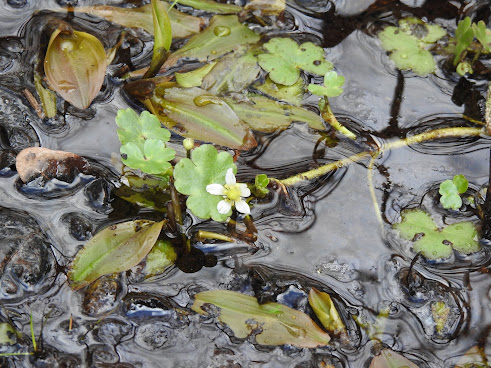We walked from Vereley car park, where a Skylark was heard, through the woods, observing two Wrens, down to Mill Lawn Brook which flows onto Ober Water and then the Lymington River. Round-leaved Water-crowfoot grew in the ditches along the path.
Numerous veteran and ancient trees, as
listed in the Woodland Trust’s Ancient Tree Inventory, many coppiced and
pollarded are in Vereley & Ridley Woods.
The sighting of inosculation
(from the Latin "to kiss"), where an Oak and a Beech had fused
together, generated some discussion. Alongside
was a veteran pollarded Oak looking like many pencils standing in tight
formation; it must be quite
old, because in 1698 Parliament banned pollarding oaks in the New Forest to
prevent a shortage of long timbers for the navy.
Between the two Woods there were a few of the increasingly scarce Petty Whin coming into flower; Bog Myrtle and one solitary Dog Violet were also spotted. A Common Buzzard could be seen spiralling upwards.
Skirting Ridley Woods we spotted a
veteran Holly, whose girth was 2.4m, quite decayed, but alive and coming into
flower.
Our tea and chocolate biscuit
stop was by fallen trees. Here we saw an
unoccupied bee’s nest in a hollowed out log, Wood Sorrel was flowering next to
it and Southern Brackets were on a dead tree beside it. In the distance a Stock Dove called.
Ridley Woods produced several birds, Robin,
Great & Blue Tits, Nuthatch, Blackbird and Song Thrush. Also here the morning’s only butterfly was
seen, a Brimstone.

Grey Disco fungus © Sue Skarstein
Dead trees supported a wide variety of
fungi, including Common Grey Disco, Beech Woodwart, Split Gill and Turkeytail. Also spotted was a False Puffball also known as Cauliflower Slime Mould.

Pollarded Beech © Sue Skarstein
 |
| Beech cotyledon © Sue Skarstein |
We then followed the hollow way where
smugglers sold their goods and near to medieval earthworks that mark the ‘old
hedge’ of Ridley Copse. From there we
went out onto the open heath, in the wet boggy ditches an abundance of bog
pondweed grew and here one of our group took an unplanned dip in the bog,
fortunately she came out unscathed.
Crossing the brook again at Ridley
Bottom, Pond Skaters were seen on the pond. A Willow Warbler sang in the trees and stayed
long enough to be spotted. Bog Myrtle
grew beside the wet areas and tadpoles swum
in a flooded area.
More water-crowfoot showed, generating some discussion about
whether or not some could be the rare hybrid New Forest Water-crowfoot Ranunculus x novae-forestae which is known to be in this area, we may never
know.
probable New Forest Water-crowfoot Ranunculus x novae-forestae © Sue Skarstein
Walking back to the cars Creeping Willow and more Petty Whin was seen, a Great Spotted Woodpecker was heard drumming and three people heard a Woodlark sing.










